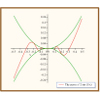Oliver Club
In the recent joint work with D.Damanik and W.Yessen we provide a description of spectral properties of the Fibonacci Hamiltonian, the most prominent model for one dimensional quasicrystals. In particular, we establish the exact identities between some of the spectral quantities (fractal dimensions of the spectrum and the density of states measure, optimal Holder exponent of the integrated density of states, transport exponents) and dynamical characteristics of the trace map, an explicit polynomial map in the three dimensional space. The proof uses some techniques inspired by previous results by Bedford and Smillie on dynamics of polynomial maps of maximal entropy. The obtained results can be used to study the properties of the square Fibonacci Hamiltonian, the first approximation to two dimensional quasicrystals. In general, the question on spectral properties of two dimensional quasicrystals (for example, on spectrum of Laplacian on Penrose tiling) is notoriously hard. But in the separable models the spectrum turns out to be the sum of spectra of one dimensional operators, and in our case this forces to study the sums of Cantor sets and convolutions of singular measures. We will describe some numerical evidences and discuss the results (joint with D.Damanik and B.Solomyak) that allow to justify rigorously some parts of the numerically obtained picture.
